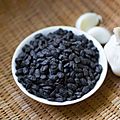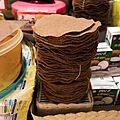List of fermented soy products facts for kids
Fermented soy products are special foods made from soybeans that have been changed by tiny living things like bacteria or fungi. This process is called fermentation. It helps to preserve the food, makes it easier to digest, and often gives it a unique, strong flavor. Many different kinds of fermented soy foods are eaten all over the world, especially in East and Southeast Asia.
Contents
What are Fermented Soy Products?
Fermentation is a natural process where microorganisms like bacteria or molds break down ingredients. For soybeans, this process can create many different textures and tastes, from thick pastes to liquids. These foods are often packed with protein and are used in cooking or as condiments to add flavor to meals.
Popular Fermented Soy Foods
Here are some well-known fermented soy products from different parts of the world:
Soy Sauces and Pastes
- Soy sauce is a very popular liquid condiment. It's made by fermenting boiled soybeans, roasted grains, salt water, and special molds. After fermentation, the mixture is pressed to get the dark, salty liquid we know as soy sauce. It started in China and is now used worldwide in cooking and as a dipping sauce.
- Tamari is a type of Japanese soy sauce. It's usually darker and has a richer flavor than other soy sauces. A great thing about tamari is that it often contains very little or no wheat, making it a good choice for people who can't eat gluten.
- Miso is a thick, salty paste from Japan. It's made by fermenting soybeans, often with rice or barley, and salt using a special fungus called kōjikin. Miso is used to make sauces, spreads, and especially miso soup, which is a staple in Japanese meals.
- Doenjang is a traditional Korean fermented soybean paste. Its name means "thick paste" in Korean. It's a key ingredient in many Korean dishes, adding a deep, savory flavor.
- Gochujang is a spicy and savory Korean paste. It's made from red chili peppers, sticky rice, fermented soybeans, and salt. Traditionally, it ferments for years in large pots outdoors, giving it a rich, complex taste.
- Doubanjiang is a spicy, salty paste from China. It's made from fermented broad beans, soybeans, salt, and sometimes chili peppers. It's especially famous in Sichuan cuisine, known for its bold and spicy flavors.
- Tianmianjiang (also called Sweet Bean Sauce) is a thick, dark brown or black Chinese sauce. It's made from wheat flour, sugar, salt, and fermented yellow soybeans. It's used in many Chinese dishes, adding a sweet and savory taste.
- Douchi are fermented black soybeans used in Chinese cooking, especially for making black bean sauce. They have a strong, salty flavor.
Unique Soy Products
- Nattō is a traditional Japanese food made from soybeans fermented with a special bacteria. It's very popular for breakfast in Japan. Nattō is known for its strong smell, unique flavor, and slimy texture, which some people need to get used to! It's a great source of protein.
- Tempeh is a traditional soy product from Indonesia. It's made by a natural fermentation process that binds soybeans into a firm, cake-like form. It's often sliced and cooked like a burger patty. Tempeh is special because it's one of the few major traditional soy foods that didn't come from China.
- Akhuni (also called axone) is a special dish from Nagaland, India. It's made from fermented soybeans. The soybeans are boiled, then fermented in a bamboo basket covered with leaves, often over a warm furnace. After a few days, they are mashed, formed into cakes, and smoked. It's often cooked with smoked pork.
- Cheonggukjang is a Korean fermented soybean paste that contains whole soybeans. It's similar to nattō and is used in Korean cooking.
- Pickled tofu is a preserved form of tofu used in East Asian cooking as a condiment. It comes in small blocks soaked in a salty brine, often with rice wine or sesame oil. It has a unique, strong flavor.
- Stinky tofu is a type of fermented tofu famous for its very strong smell! It's made by fermenting tofu in a special brine that can include vegetables, meat, and herbs. The fermentation can take several months. Despite its smell, it's a popular street food in China.
- Thua nao are fermented soybeans found in Myanmar and Thailand, especially among the Shan people. They come in fresh or dried forms and are used to add flavor to dishes.
See also
- List of fermented foods
- List of food pastes
- List of meat substitutes
- List of soy-based foods
- Sweet bean paste
Images for kids





















